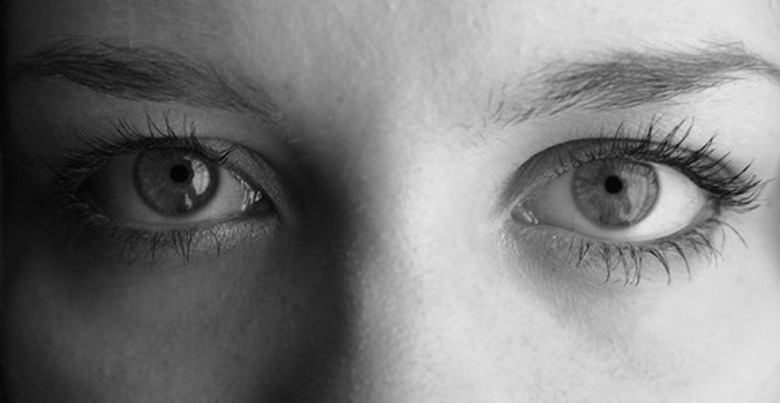Rare Human Eye Colors
More than half of the people in the world have brown eyes. Also, 8 percent of the world's population has hazel eyes, and another 8 percent has blue eyes. Although people with green eyes are relatively rare, accounting for less than 2 percent of the world's population, that still adds up to approximately 150 million people across the globe. Eye color distributions vary by geographic region. In East Asia and Africa, for example, dark brown eyes are the dominant eye color. By comparison, in parts of Western and Northern Europe, blue eyes are disproportionately represented, and light brown eyes are more common than dark brown ones. There are other eye colors, however, that are even rarer in humans, such as amber, violet and red. These eye colors are usually the result of genetic inheritance or disease.
TL;DR (Too Long; Didn't Read)
Green is the rarest of the common eye colors. Even rarer human eye colors include violet and red, and a condition that causes multiple eye colors to occur simultaneously.
The Pigmented Layers of the Iris
The Pigmented Layers of the Iris
The part of the human eye that forms a colored ring around the pupil is called the iris. In the iris, there are two pigmented layers; one is called the pigmented epithelium, and in front of it lies the stroma. People with brown eyes have melanin in both the epithelium and the stroma; the darker their eyes, the more concentrated the melanin. People with blue eyes have the same brown pigmentation from melanin in the epithelium layer of the iris, but little or no pigmentation in the stroma. This causes a scattering of light as it hits the eye, causing the irises to appear blue. There are many other factors that create the diverse spectrum of eye colors, such as collagens and other proteins in the stroma, and a yellow pigment called lipochrome present in green eyes.
Blue, Violet and Grey Eyes
Blue, Violet and Grey Eyes
Most Caucasian babies are born with blue eyes, although many infants grow into children with brown or hazel eyes. While blue eyes are fairly common among humans, some people have blue-grey or even plain grey eyes. Even less commonly, people have violet eyes, including the late actress Elizabeth Taylor.
Violet and grey eyes are considered to be variations on blue eyes, in that they have the same pigmentation patterns. The irises have melanin in the epithelium, but very little melanin in the stroma layer. The reason that they appear grey or violet instead of blue is related to the collagen molecules in the stroma, which scatter light differently depending on their size. One theory suggests that the collagen molecules in violet irises might be the smallest, scattering only violet light, while the collagen molecules in blue irises are an intermediate size, and the collagen molecules in grey irises are the largest and scatter many colors of light.
The Cause of Red Eyes
The Cause of Red Eyes
Red eyes are caused by a group of diseases called albinism. There are several kinds of albinism, and each affects the body somewhat differently. Generally, they are disorders that are inherited genetically which involve hypopigmentation of the parts of the body like the hair, skin or eyes. This means that there is little or no melanin in the affected areas of the body.
Most people with albinism do not have red eyes, although many have tan or pale blue eyes. They also tend to have pale retinas, which are visible during an exam by an eye doctor, and they often experience other eye problems such as sensitivity to light, poor vision or nystagmus, which is the involuntary back and forth movement of the eyes.
When a person with albinism's eyes do appear red, it is because they are lacking melanin in both the epithelium layer and the stroma layer of their irises. People with red eyes do not actually have red irises. Most people's blood vessels are obscured by the pigment in their irises, but for people lacking melanin in their irises due to albinism, the blood vessels are visible enough to create a pink or red appearance.
The Rarest Eye Color
The Rarest Eye Color
Perhaps the rarest eye color is not one color at all, but multicolored eyes. This condition is called heterochromia iridis. A person can be born with this condition, it can develop in infancy, or it can develop as a symptom of a systemic disease or after an injury to the eye. Like albinism, heterochromia can occur in both humans and many animals. In one form of heterochromia, called central heterochromia, there is a ring of color around the pupil that is distinctly different from the color of the rest of the iris. In another form, called partial heterochromia, one part of one eye's iris is a different color than the rest of the iris or the other eye. For example, the left eye and half of the right eye might be brown, and the other half of the right eye might be green. In complete heterochromia, which is typically inherited, each eye is a different color.
Cite This Article
MLA
E., Rebecca. "Rare Human Eye Colors" sciencing.com, https://www.sciencing.com/rare-human-eye-colors-6388814/. 20 July 2018.
APA
E., Rebecca. (2018, July 20). Rare Human Eye Colors. sciencing.com. Retrieved from https://www.sciencing.com/rare-human-eye-colors-6388814/
Chicago
E., Rebecca. Rare Human Eye Colors last modified March 24, 2022. https://www.sciencing.com/rare-human-eye-colors-6388814/
